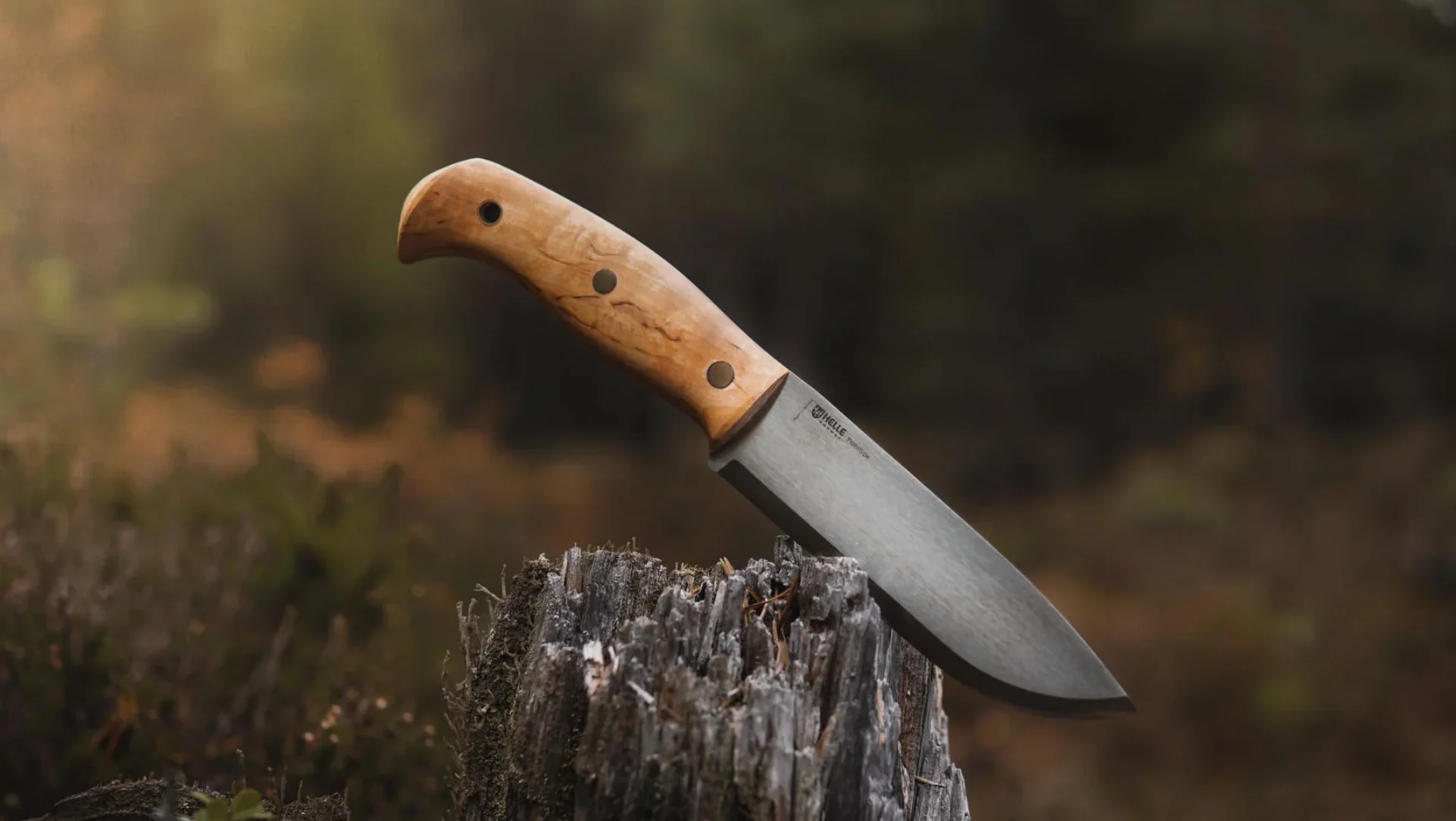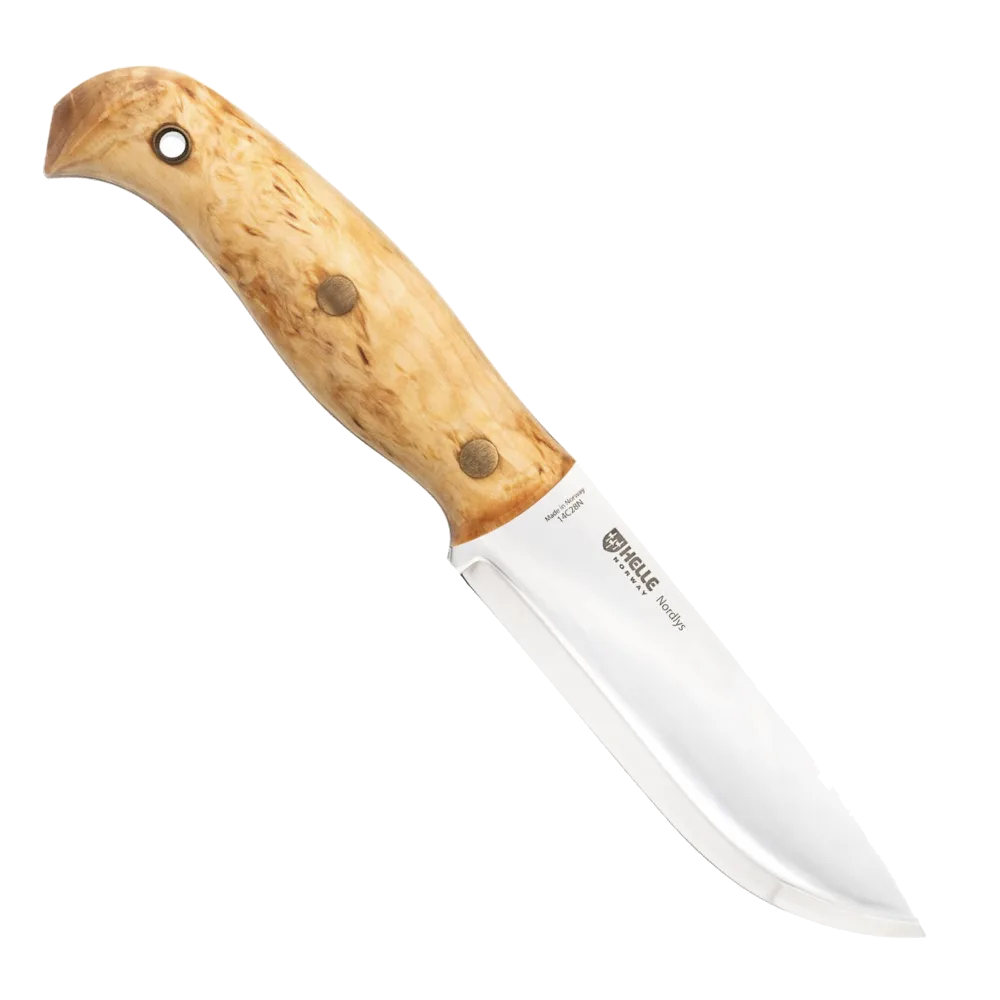Helle is a Norwegian knifemaker that has been doing business for 92 years. Norway, like Sweden and Finland, has a knifemaking tradition that goes back to a time when Scandinavians wore chain mail shirts, gave their swords pet names, such as Skofnung and Gungnir, and pillaged towns in England, Ireland, and France for fun and profit. I have, since 2012, been using a Helle knife whose design is taken directly from one that was discovered in a Viking tomb.
Helle does things its own way. Its handles, in the era of Micarta and G-10, are made of birch, which grows from seeds in the ground. For steels, they use three kinds of proprietary laminates and a pair of powder-technology dedicated cutlery steels. I tell you this because Helle has introduced a new knife called the Nordlys that should be of interest to hunters, which I will tell you all about it a minute. But first, a bit of background.
The Nord and the Nordlys

Two years ago, Helle introduced us to the Nord. It’s a big, hefty knife with the best handle I’ve groped in a long, long time. Helle describes it as a “powerful tool,” and it is that. The handle is curly birch, and the blade is a highly advanced powder-technology steel that’s milled by the Swedish company Alleima (formerly Sandvik). It’s designated as 14C28N, and is one of the handful of super steels that combine every desirable quality you want in a knife blade, including immunity to rust. Its formula includes 14 percent chromium, and that is true stainless.
I did not take Nord into the fields and streams. It went to my garage workbench, for which my pet name is Corrosion Corner, where all steel tools must be kept oiled, and it gets all the really ugly, difficult cutting jobs, including slicing up cardboard boxes. As F&S's own Travis Smola noted in his test of tactical knives, cutting cardboard, especially the heavy, corrugated stuff, is the worst thing you can do to a knife edge because it’s both tough and highly abrasive. I do it because the carters won’t pick up intact shipping boxes. I’m pleased to report that Nord has neither dulled (I strop it when the mood takes me) nor rusted.
It is, however, too big to be an ideal hunting knife, and so Helle has shrunk the Nord into a smaller version called the Nordlys, and the Nordlys is an ideal hunting knife. The Nordlys’ blade is 5 inches long, which is ½-inch shorter than the Nord's, and it’s noticeably narrower. The grip is 5 inches, which is ¼-inch shorter than Nord’s, and is slimmer. Because of these modest differences, the feel of the new knife is much different. It’s nimble rather than powerful, and is ideal for disassembling critters that get in the way of your bullets and arrows.
Related: The 8 Best Hunting Knives of 2024
The Nordlys’ blade requires only that you wipe it free of blood and other ugh, but the birch handle does need some upkeep. Birch is a very hard, tough, tight-grained wood which Helle cuts and processes itself. Because birch is not an oily wood like rosewood or cocobolo, the processing includes a three-day soak in linseed oil. If you get a birch handle wet a lot, or get blood on it, that will leech out the linseed, and, at the least, your handle will cease to look as nice as it did. Helle recommends that if you’ve used the Nordlys hard, you put a dab of linseed on your fingertip and work it into the wood, including the end grain. This will keep your handle looking new just about forever.
The Nordlys, like the Nord, has a Scandi-grind blade, which allows a strong edge with a lot of steel behind it. However, some knife users believe that Scandi edges don’t slice as easily as flat-ground edges, so probably in October, Helle is bringing out a flat-ground Nordllys with a blade forged from 12C27, which is the steel from which 14C28N was developed, and is used for all Helle’s flat-ground knives. How come? Because it’s not tempered quite as hard, and hence it sharpens more easily to what Helle calls a “hair-popping edge.” It will slice like a son of a bitch.

Look at it this way: If you want a nimble, all-around heavy-duty knife that can double very nicely as a hunting knife, get the Scandi-grind version. If you’re after a hunting knife that is going to spend most of its working life field-dressing game but can also whittle fuzz sticks, wait for the flat-grind. Or you can by both.
About the sheath. It’s a very nice Scandinavian style that swallows everything but the last half-inch of handle. Helle doesn’t say anything about this, but if you look inside, halfway down where the blade sits, there’s a hard liner, put there so the knife can’t cut through the leather. I know of only one other company—DiamondBlade—that takes the trouble to do this, and that’s because like Helle, they make very, very sharp knives.
The Nordlys sells for $229. I like it immensely, and can’t think of a thing to criticize. In fact, if you can find a better hunting knife at that price, I will send you my chain mail shirt for you to wear when you get drunk on mead or go pillaging.



